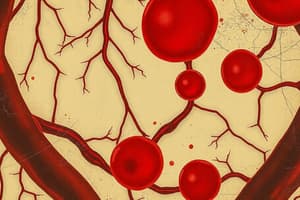Podcast
Questions and Answers
Why is the human circulatory system classified as a double circulatory system?
Why is the human circulatory system classified as a double circulatory system?
- Because the heart has two ventricles and two atria that work independently.
- Because blood is pumped away from the heart at high pressure in arteries and returns at low pressure in veins.
- Because blood contains red and white blood cells.
- Because it involves two separate circuits: one carrying oxygenated blood and the other carrying deoxygenated blood. (correct)
What would happen to red blood cells if they were placed in a solution with a significantly higher water concentration than their internal environment?
What would happen to red blood cells if they were placed in a solution with a significantly higher water concentration than their internal environment?
- The cells would remain the same as the water concentration doesn't affect them.
- The cells would shrink due to water moving out of them via osmosis.
- The cells would swell and potentially burst (lyse) due to water moving into them via osmosis. (correct)
- The cells would actively pump water out to maintain equilibrium.
What is the primary reason blood plasma contains salts and other chemicals?
What is the primary reason blood plasma contains salts and other chemicals?
- To facilitate the transport of oxygen.
- To aid in blood clotting.
- To maintain a concentration similar to that within blood cells, preventing osmotic imbalances. (correct)
- To provide nutrients to the blood cells.
Which of the following statements accurately compares blood flow in arteries and veins?
Which of the following statements accurately compares blood flow in arteries and veins?
What is the consequence of red blood cells lacking a cell wall when placed in a hypotonic solution?
What is the consequence of red blood cells lacking a cell wall when placed in a hypotonic solution?
How does the presence of salts and chemicals in blood plasma prevent the lysis of red blood cells?
How does the presence of salts and chemicals in blood plasma prevent the lysis of red blood cells?
Considering the function of arteries and veins, what structural adaptations do arteries possess to withstand the pressure of blood being pumped from the heart?
Considering the function of arteries and veins, what structural adaptations do arteries possess to withstand the pressure of blood being pumped from the heart?
If a patient's blood plasma has a lower salt concentration than their red blood cells, what immediate effect would this have on the red blood cells?
If a patient's blood plasma has a lower salt concentration than their red blood cells, what immediate effect would this have on the red blood cells?
Why is it essential for blood to return to the heart, even at low pressure in the veins?
Why is it essential for blood to return to the heart, even at low pressure in the veins?
In the context of the circulatory system, what is the significance of its classification as 'double'?
In the context of the circulatory system, what is the significance of its classification as 'double'?
Flashcards
Arteries
Arteries
Vessels that carry blood away from the heart at high pressure.
Veins
Veins
Vessels that return blood to the heart at low pressure.
Double Circulatory System
Double Circulatory System
A system where blood passes through the heart twice in each complete circuit of the body.
Osmosis
Osmosis
Signup and view all the flashcards
Lysis
Lysis
Signup and view all the flashcards
Blood Plasma
Blood Plasma
Signup and view all the flashcards
Study Notes
- Blood moves away from the heart through arteries at high pressure.
- Blood returns to the heart through veins at low pressure.
- The human circulatory system is a double circulatory system.
- If red blood cells are in a high concentration of water, osmosis will cause water to move into the cell.
- Without a cell wall, the red blood cells will lyse (burst).
- Salts and other chemicals are in blood plasma to maintain a concentration similar to that of blood cells.
Studying That Suits You
Use AI to generate personalized quizzes and flashcards to suit your learning preferences.





